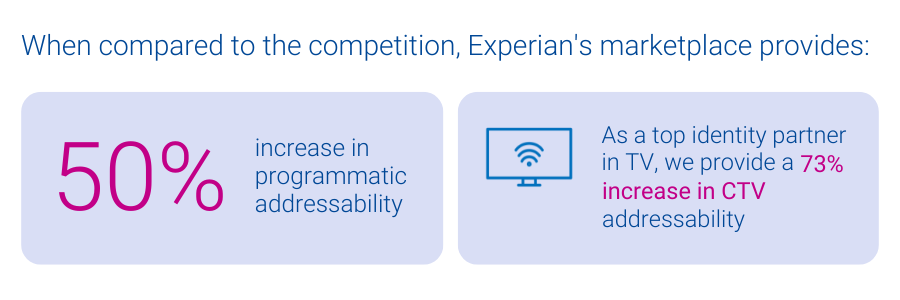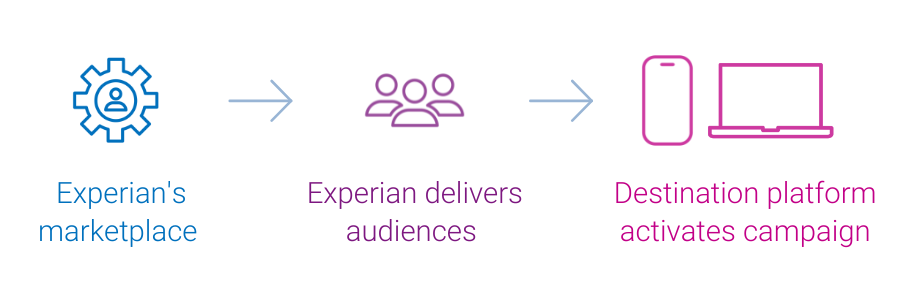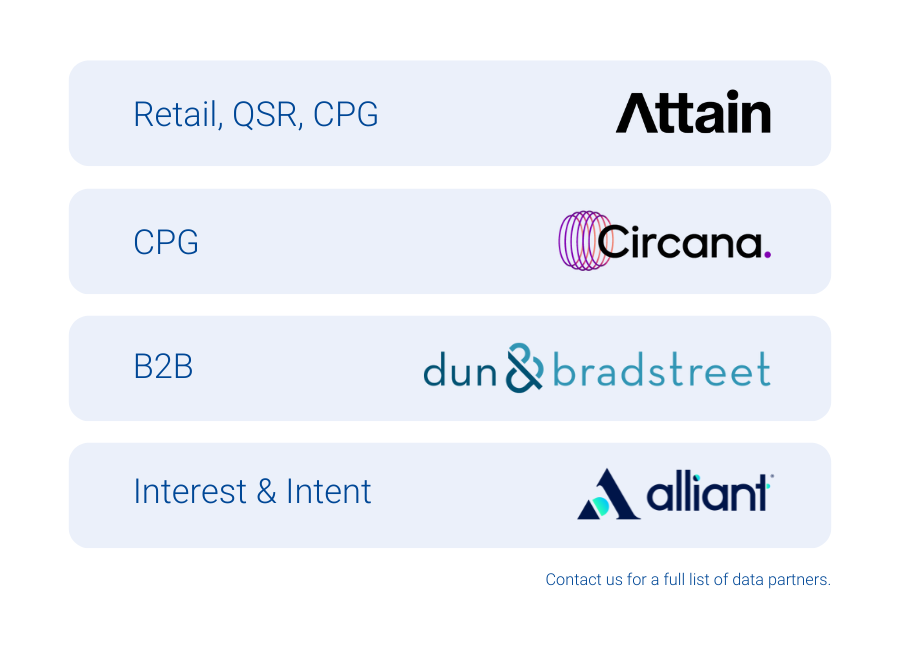
In a perfect world, we’d all have a single, go-to grocery store that carried everything on our shopping list – fresh produce, gourmet coffee beans, rare spices, and maybe even that special-grade olive oil, right alongside our wholesale bulk purchases at unbeatable prices. It would be convenient and efficient, and it’d save a lot of driving around town.
The changing data marketplace: From one-stop shop to specialized selection
For a long time, data buyers enjoyed something similar in their world: a small set of large-scale data marketplaces that offered a wide array of audiences, making it easy to load up on whatever you needed in one place. Not only are there fewer places to pick everything up, but new factors like privacy and signal deprecation are placing a spotlight on quality and addressability.
Just as our dinner plans are growing more ambitious insofar as we want health, flavor, value, and convenience all in one place – so are our data strategies. Instead of a single steak-and-potatoes meal, today’s data marketplace operators might be cooking up a complex menu of campaigns.
“Experian has been a longstanding partner of DISH Media, and we’re excited to be an early adopter of their marketplace which leverages the foundation of their identity solutions to ensure maximum cross-channel reach as we look to expand the breadth and depth of data we use for addressable TV.”
Kemal Bokhari, Head of Data, Measurement & Analytics, DISH Media
As a result, data buyers are beginning to shop around. Some still rely on large-scale marketplaces for familiar staples, but now they have reasons to explore other options. Some are turning to providers known for offering top-tier, transparently sourced segments. Others are focusing on specialty providers that excel in one area.
A more selective approach to data buying
In this environment, choosing where to “shop” for data is becoming more deliberate and selective. Data buyers aren’t just thinking about broad scale; they’re looking to prioritize quality, durability, data privacy, and differentiation. They need to place higher value on data marketplaces that can maintain audience addressability over time, despite signal loss. Sometimes, that means accepting a smaller assortment in exchange for tighter vetting and more reliable targeting. Other times it means mixing and matching – stopping by one marketplace for premium segments and another for cost-friendly, wide-reaching data sets. Either way, they can benefit from having more choices.
“Experian has been a longstanding partner of DISH Media, and we’re excited to be an early adopter of their marketplace which leverages the foundation of their identity solutions to ensure maximum cross-channel reach as we look to expand the breadth and depth of data we use for addressable TV.”
Kemal Bokhari, Head of Data, Measurement & Analytics, DISH Media
Experian’s marketplace: A trusted source for high-quality data
Experian’s vetted and curated blend of data partners and vertically-aligned audiences offers a trusted specialty store for data buyers. Experian’s marketplace, powered by identity graphs that include 126 million households, 250 million individuals, and 4 billion active digital IDs, enables partner audiences to be easily activated and maintain high addressability across display, mobile, and connected TV (CTV) channels. In particular, Experian’s marketplace provides:


The future of data marketplaces: Precision and flexibility matter
The evolution of data marketplaces reflects the industry’s shifting priorities. Data buyers seek specificity, reliability, and adaptability to align with their diverse campaign needs. The best data strategy, much like the best grocery run, isn’t about grabbing everything in one place – it’s about carefully selecting the right ingredients to create the perfect recipe for success. This shift underscores the importance of flexibility and precision as data buyers navigate a landscape shaped by privacy regulations, signal loss, and evolving consumer expectations.

As data marketplaces adapt to meet these demands, they are redefining what it means to deliver value. Experian’s marketplace enables buyers to strike the perfect balance between reach and quality by offering enhanced match rates, precise audience planning, and seamless distribution. In this new era, data buyers have the tools and options to craft campaigns that are impactful and aligned with the increasingly selective and privacy-conscious digital landscape. The key is recognizing that today’s data strategy is about utilizing the strengths of many to create a cohesive and effective whole.
If you’re interested in learning more about Experian’s marketplace or becoming an active buyer or seller in our marketplace, please contact us.
Latest posts

If you live in an early primary or caucus state, you’ve probably already had your fill of political advertising. According to The Washington Post, politicians and political groups spent more than $23 million on campaign television ads as of December 1, 2011. With record ad spending predicted for the 2012 election, the rest of the nation will soon be bombarded with television ads “approved by” politicians from the left, right and the center of the political spectrum. Candidates and those groups that support them need to know where to allocate their ad dollars to either connect with their base or reach swing voters. Experian Simmons analyzed the viewing audiences of over 600 broadcast, cable and syndicated TV programs that were measured in our most recent National Consumer Study in order to pinpoint opportunities for politicians to reach partisans and middle of the road voters. This analysis has already gathered the attention of major media outlets, including Entertainment Weekly, The Washington Post, AOL, Huffington Post and more. Below are the entertainment and news programs that score the highest concentration of liberal Democrats among their viewers, Conservative Republicans and Middle-of-the-Road Voters registered with any party. Be sure to check out our free 2011 PoliticalPersonas report in which Experian Simmons delivers the mindset of the American voter, including attitudes, brand preferences and their penchant for social media. You can also check out a similar analysis of TV preferences of political partisans that we conducted last year here and here.

Social media continues to be one of the fastest growing industries online. Between September 2010 and September 2011 visits to Social Networks and Forums have increased by nearly 11% and, if you saw my Internet clock blog last month, social media accounts for nearly a quarter of all time spent online. But when are people engaging with social media the most? We took a look at the UK Internet visits to the Social Networks and Forums category each month between 2009 and 2011. We then averaged those visits across the months to see the seasonal trends with social media. What this shows is that social media usage is at its lowest at the beginning of the year and climbs throughout the course of the year towards a peak in December. Over the last three years December has always seen the peak of online visits and in fact last Christmas Day Facebook overtook Google for the first time ever in terms of UK Internet visits. We know that Christmas is a very social time and a time for sharing messages with loved ones, friends and family, so the increased visits to social networks during December is to be expected. More generally, what this graph shows is that social media observes two seasonal trends. The first is an early summer peak in visits in June, before a decline in visits in July and August. This seasonal dip in July and August can be explained by summer holidays where people are more likely to go abroad and therefore less likely to be using social networks. The second seasonal trend is a recovery in visits in September and October before a yearly peak at Christmas. With students starting university terms, kids going back to school, and the working population returning from holiday this would account for the increased interaction in September and October before the Christmas surge. In particular what we’ve seen in September data is a resurgence in market share of visits to Facebook, which bounced back after the summer dip to account for nearly 52% of all visits to a social network. The message here for brands who want to capitalise on social media traffic is to start implementing their social strategy now rather than waiting for Christmas. As October is the second busiest month of the year for social media visits we are expecting over 800 million hours to be spent on social networks this month, which represents a huge opportunity to engage with new and existing customers online. Follow Hitwise UK on Twitter.

Marketing by mobile device is now as popular as ever as retailers send shoppers text messages with special offers and sales. More and more companies are also offering their own phone apps so customers can search for product information and deals on the go. With more than 80 million mobile internet users in the United States, retailers can really benefit from this communication channel. One perk for shoppers is that they no longer have to save and print out coupons from emails! Through their mobile phones, shoppers can receive texts about sales and coupons as they enter stores. They can keep track of their favorite stores and make a purchase anywhere/anytime. One perk for shoppers is that they no longer have to save and print out coupons from emails! All they have to do is show the coupon on their phone at the point of purchase to redeem their coupon. With “QR” bar codes or quick response codes directly on coupons on your phone, savings can be redeemed on the spot. While many people don’t know yet that they can use QR codes on a mobile device, retailers have only begun to take advantage of this technology and more customers are now able to scan items in a store and pay for it using their mobile phones. While it’s just the beginning of a new era, mobile marketing is taking us by storm and now is the perfect time to put this trend into effect.